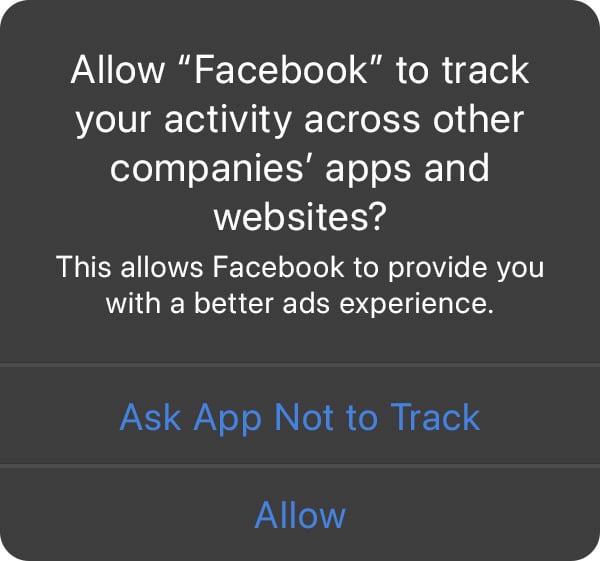What’s Facing a Bigger Challenge Than iOS 14.5? Unified ID 2.0

By Steven Ohrnstein and Jon Ahuna
Apple’s new AppTrackingTransparency (ATT) feature bundled within iOS 14.5 epitomizes the level of coordination necessary to implement an operating system-wide consumer opt-in strategy, even one that has everything going for it.
As of this writing, the global implementation rate by developers of ATT is sitting at 22% according to AppsFlyer.
It raises the question: What happens when a similar concept attempts to solve not just mobile in-app data tracking on a single operating system, but rather the implementation of technology across all browsers and devices, as well as millions of websites, apps and CTVs?
Well, that’s what Universal ID 2.0 (UID2.0) has set out to do. And we can learn a thing or two about what lies ahead for UID2.0 by comparing it to the complexities of the adoption of ATT.
With ATT, getting users to ‘Allow’ was supposed to be the hard part, not implementing the prompt in the first place.

On Jan. 28 – Data Privacy Day – Apple announced that ATT would be a part of their forthcoming iOS 14.5 release that would be launched later in the year. Online forums were immediately buzzing with requests for detailed technical documentation, and industry news sites like AdExchanger published headlines like “What’s Apple Thinking?”
Fast forward to the weeks following iOS 14.5’s release, April 26. We saw ATT implementation rates by developers of approximately 14%. Pre-prompts with conflicting messaging are confusing users, as developers struggle to explain the quid pro quo of consent, with varying degrees of success. (If you really want to see what we mean, click here for a good time).
Knowing this, it’s certain an industry-wide initiative like Unified ID 2.0 faces an uphill battle.
UID2.0 is the proposed open-sourced solution to a world without cookies. It coalesces around an email-based identifier, which offers user-level privacy controls and a single sign-on (SSO) component that persists across media properties with built-in advertising consent. Understandably, the concept has been welcomed by an industry losing its core cookie-based identifier, which companies have built entire advertising solutions around.
Like ATT, initial technical documentation around UID2.0 had been sparse and outstanding questions remain around how SSO can be supported cross-publisher without an additional individual publisher advertising consent prompt (with looming privacy initiatives like CCPA and GDPR). The answers are murky at best.
It’s important to note here that UID2.0 lacks the resources of Apple, yet at the same time must work across operating systems and balance varying incentive structures.
Unified ID 2.0 lacks the ease of opting in offered by ATT, an added challenge for publishers and consumers.
Something ATT does have going for it is that user consent for data tracking is a single “Allow” click that’s tied to a persistent and reliable Apple ID on a user’s device. Because it is meant to be a solution across all devices, UID2.0 is in a much trickier situation.
The publisher/consumer relationship would first be predicated on a user’s willingness to sign in with a valid email address. Publishers that have pay walls or email gates have long noted they are a hindrance to increasing pageviews, with 77% of publishers having authenticated traffic less than half the time, according to Digiday.
With the lack of support from Google and Apple, whose respective browsers represent the largest market share, every publisher would need to support an email gate in order for UID2.0 to work. This email gate would be engaged prior to accessing the content alongside a potential advertising consent prompt, allowing the consumer to opt in on an individual publisher basis. This will likely impact consent and scale of UID2.0, limit the content owners who are eligible to participate and/or potentially hinder media owner monetization efforts.
UID2.0 will also need to make a tradeoff between scale and accuracy. If a user is required to “validate” her email alongside cookie prompts, respond to potential advertising consent messaging and also log in in via email all while trying to read a quick article on her lunch break, it adds yet another hindrance prior to a value exchange between that user and the content provider.
On the other hand, if UID2.0 doesn’t require the email to be validated, most consumers will mash some text together within a publisher’s email prompt to quickly bypass the email gate, making the solution worthless … which leads us to measurement.
ATT has figured out targeting and measurement. UID2.0 Hasn’t.
UID2.0 doesn’t just need consent from publishers that are trying to monetize their inventory. It needs brand marketers who are selling their goods and services both online and offline to consent too.
Having publisher consent will enable UID2.0 to be passed in the bid stream for targeting, but the brand conversion would also need to support the equivalent ID in order to provide necessary data in the conversion log for seamless attribution – and there’s plenty of reason to believe brands won’t be champing at the bit to share their coveted CRM lists back to the open web for competitive conquesting.
The willingness – or lack thereof – of brands to share the emails and data points of users who have purchased a product or performed an action would be a significant blocker to measurement. If the brand doesn’t adopt UID2.0, then a host of other technical work would be required to make measurement a reality.
And at the end of the day, if a brand can’t measure the effectiveness of their media, it puts into question the effectiveness of an ID altogether.
The industry needs a better solution.
There’s no question that the effort to create an industry-wide alternative to the cookie is an honorable one. But when considered through the lens of ATT implementation and all the challenges facing the adoption of an opt-in mechanism within just a single operating system, it’s hard to believe UID2.0 as it’s currently ideated is poised to succeed.
For any proposed solution to work, publishers and brands need scale and measurability. But for the reasons outlined above, UID2.0 likely won’t be able to guarantee either. Instead, the industry needs a better solution, one that offers scalability and addressability while maintaining privacy compliance and allowing brands to understand that their advertising efforts are working.
STAY IN THE LOOP WITH OUR NEWSLETTER
Sign up to get Viant news and announcements delivered straight to your inbox.
Sign up to get Viant news and announcements delivered straight to your inbox.
